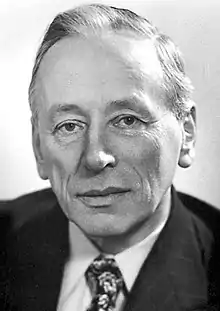Frits Zernike | |
|---|---|
 Zernike in 1953 | |
| Born | Frits Zernike 16 July 1888 |
| Died | 10 March 1966 (aged 77) Amersfoort, Netherlands |
| Nationality | Dutch |
| Alma mater | University of Amsterdam |
| Known for | Phase-contrast microscopy Zernike polynomials Ornstein–Zernike equation Van Cittert–Zernike theorem |
| Spouse | Dora van Bommel van Vloten (1930-1945) Lena Koperberg-Baanders (since 1954)[1] |
| Awards | Rumford Medal (1952) Nobel Prize in Physics (1953) Fellow of the Royal Society[2] |
| Scientific career | |
| Fields | Physics |
| Institutions | Groningen University |
Frits Zernike (Dutch pronunciation: [ˈfrɪtˈsɛrnikə]; 16 July 1888 – 10 March 1966) was a Dutch physicist and winner of the Nobel Prize in Physics in 1953 for his invention of the phase-contrast microscope.
Early life and education
Frits Zernike was born on 16 July 1888 in Amsterdam, Netherlands to Carl Friedrich August Zernike and Antje Dieperink. Both parents were teachers of mathematics, and he especially shared his father's passion for physics. He studied chemistry (his major), mathematics and physics at the University of Amsterdam.
Academic career
In 1912, he was awarded a prize for his work on opalescence in gases. In 1913, he became assistant to Jacobus Kapteyn at the astronomical laboratory of Groningen University. In 1914, Zernike and Leonard Ornstein were jointly responsible for the derivation of the Ornstein–Zernike equation in critical-point theory. In 1915, he became lector in theoretical mechanics and mathematical physics at the same university and in 1920 he was promoted to professor of mathematical physics.[3]
In 1930, Zernike was conducting research into spectral lines when he discovered that the so-called ghost lines that occur to the left and right of each primary line in spectra created by means of a diffraction grating, have their phase shifted from that of the primary line by 90 degrees.[4] It was at a Physical and Medical Congress in Wageningen in 1933, that Zernike first described his phase contrast technique in microscopy. He extended his method to test the figure of concave mirrors. His discovery lay at the base of the first phase contrast microscope, built during World War II.
He also made another contribution in the field of optics, relating to the efficient description of the imaging defects or aberrations of optical imaging systems like microscopes and telescopes. The representation of aberrations was originally based on the theory developed by Ludwig Seidel in the middle of the nineteenth century. Seidel's representation was based on power series expansions and did not allow a clear separation between various types and orders of aberrations. Zernike's orthogonal circle polynomials provided a solution to the long-standing problem of the optimum 'balancing' of the various aberrations of an optical instrument. Since the 1960s, Zernike's circle polynomials are widely used in optical design, optical metrology and image analysis.
Zernike's work helped awaken interest in coherence theory, the study of partially coherent light sources. In 1938 he published a simpler derivation of Van Cittert's 1934 theorem on the coherence of radiation from distant sources, now known as the Van Cittert–Zernike theorem.[5][6]
Death
He died in hospital in Amersfoort in 1966 after suffering illness the last years of his life.[7] His granddaughter is journalist Kate Zernike.[8]
Honours and awards
In 1946, Zernike became member of the Royal Netherlands Academy of Arts and Sciences.[9]
In 1953, Zernike won the Nobel Prize in Physics, for his invention of the phase-contrast microscope, an instrument that permits the study of internal cell structure without the need to stain and thus kill the cells.[2]
In 1954, Zernike became an Honorary Member of The Optical Society (OSA).[10] Zernike was elected a Foreign Member of the Royal Society (ForMemRS).[2]
The university complex (Zernike Campus) to the north of the city of Groningen is named after him, as is the crater Zernike on the Moon.
Zernike's great-nephew Gerard 't Hooft won the Nobel Prize in Physics in 1999.[11]
The Oz Enterprise, a Linux distribution, was named after Leonard Ornstein and Frederik Zernike.
See also
References
- ↑ "The Nobel Prize in Physics 1953".
- 1 2 3 Tolansky, S. (1967). "Frits Zernike 1888-1966". Biographical Memoirs of Fellows of the Royal Society. 13: 392–402. doi:10.1098/rsbm.1967.0021. S2CID 123209453.
- ↑ Frits Zernike 1888-1966
- ↑ Zernicke, Frits (1935). "Das Phasenkontrastverfahren bei der mikroskopischen Beobachtung". Zeitschrift für technische Physik. 16: 454–457.
- ↑ Van Cittert, P. H. (1934). "Die Wahrscheinliche Schwingungsverteilung in Einer von Einer Lichtquelle Direkt Oder Mittels Einer Linse Beleuchteten Ebene". Physica. 1 (1–6): 201–210. Bibcode:1934Phy.....1..201V. doi:10.1016/S0031-8914(34)90026-4.
- ↑ Zernike, F. (1938). "The concept of degree of coherence and its application to optical problems". Physica. 5 (8): 785–795. Bibcode:1938Phy.....5..785Z. doi:10.1016/S0031-8914(38)80203-2.
- ↑ Van Berkel, Klaas; Van Helden, A.; Palm, L. (1999). "Frits Zernike 1888–1966". A History of Science in The Netherlands. Survey, Themes and Reference. Leiden: Brill. pp. 609–611. ISBN 90-04-10006-7.
- ↑ New York Times Weddings: Kate Zernike and Jonathan Schwartz" September 25, 2005
- ↑ "Frederik (Frits) Zernike (1888–1966)". Royal Netherlands Academy of Arts and Sciences. Retrieved 17 July 2015.
- ↑ "OSA Honorary Members".
- ↑ Robert Goldwyn. "Gerardus 't Hooft Science Video Interview".
External links
 Media related to Frits Zernike at Wikimedia Commons
Media related to Frits Zernike at Wikimedia Commons
- Frits Zernike Photo
- Frits Zernike on Nobelprize.org including his Nobel Lecture, December 11, 1953 How I discovered phase contrast
- Extended Nijboer–Zernike theory
- Museum Boerhaave Negen Nederlandse Nobelprijswinnaars
- H. Brinkman, Zernike, Frits (1888–1966), in Biografisch Woordenboek van Nederland.
- Prominente Groningse hoogleraren Frits Zernike (1888–1966)
- Frits Zernike (1888–1966) biography at the National library of the Netherlands.
- The Ornstein-Zernike equation and integral equations
- Multilevel wavelet solver for the Ornstein-Zernike equation Abstract
- Analytical solution of the Ornstein-Zernike equation for a multicomponent fluid
- The Ornstein-Zernike equation in the canonical ensemble